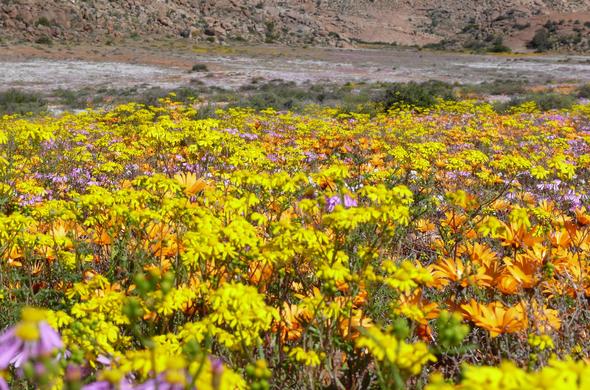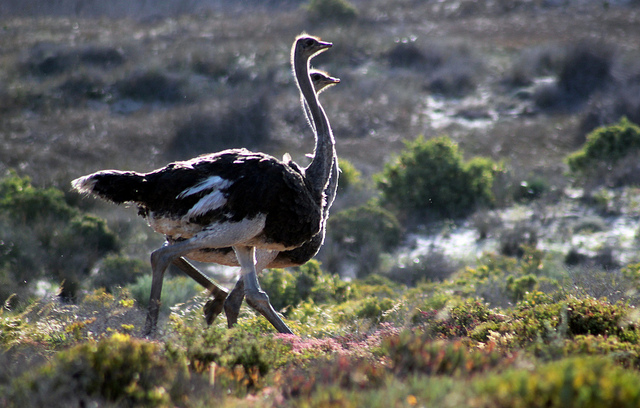Table of Contents
Best 5 Reasons To Visit Namaqua National Park In South Africa
The best 5 reasons to visit Namaqua National Park include; diversity of wildlife, wild flowers, roaming ostriches, sight seeing and photography in South Africa.
1. Diversity Of Wildlife And Marine Wonders In Namaqua National Park
Namaqua National park is home to a variety of bio diversity which involves both wild species of flora and fauna with animals like Leopard; Black backed jackal, Porcupine, Klipspringer, Aardvark, Baboon, Steenbok, Duiker and many more with several endemic species, amphibians and reptiles as well as plant species like when the environment begins to change into a sea of color. bursting with unique varieties of flora, including Yellow, Orange, White, and Purple flowers as well as many others, species that have adapted to these challenging circumstances of the country’s harsh conditions.


2. Wild Flowers In Namaqua National Park
 |
3. Roaming Ostriches In Namaqua National Park
In Namaqua National Park these enormous birds frequently can be seen sprinting across the middle of the wildflower fields by visitors frequently encountering ostriches in pairs as they freely explore the park, It’s better for tourists to keep distance and observe them from afar since they can still be easily startled by humans.
The ostrich, a huge flightless bird of the genus Struthio, with two live kinds endemic to wide regions of sub-Saharan Africa and the Somali ostrich indigenous to the Horn of Africa. They are the heaviest living birds, capable of running at 70 km/h, the fastest birds on land, and their feathers are used for ornamentation and feather dusters. They also lay the largest eggs of any living land mammal. Additionally, their skin is utilized to make leather goods.
 
|
4. Sight Seeing In Namaqua National Park
Namaqua National Park is a semi-natural reserve, a biome of several species of flora and fauna that tourists cannot find anywhere else in the world and the main purpose of opening this park was to work and conserve the wildlife and flora which were found in the dry regions of the park, which later has brought about huge numbers of tourists to explore its beauty and visit south africa.
The Park has a growing popularity spread over a wide due to sheltering 5000 different species of plants, animals and the eye catching beauty of blossoming flowers among others. Red hartebeest, gemsbok, and springbok are just a few of the large antelope species that have been successfully restored to Namaqua National Park. However, smaller mammals make up the majority of the local biodiversity. In the mountain passes, keep an eye out for baboons and klipspringer or steenbok antelope. Black-backed jackals are regularly seen, and nocturnal predators like caracals, African wild cats, bat-eared foxes, and Cape foxes are also common. The leopard is the biggest predator in the park, but due to their nocturnal and solitary habits, one seldom ever sees these gorgeous animals. The world’s smallest tortoise species and a native of Namaqualand, the endangered speckled padloper should also be on your radar.
A display of the stunningly beautiful blooming wild vibrant brightly coloured flowers that create an awesome inspiring view, Succulent plant species just not like any other plants, rich diversity of wildlife with the world’s smallest known tortoise, humid summers, variable cold temperature in the winter season with occasional rainfall all of which call for tourist viewing and experience in Namaqua National Park.
5. Photography In Namaqua National Park
Namaqua has got numerous small bays where the endemic Dolphins play and leap within the waves, a sandy white beach, the flat lands where Hartebeests, Steenbok among others match within the beautiful purples, yellows, pinks and orange flowers during spring and summer.
The diverse scenery and home to the wildlife like the Chacma Baboons, Jackal Buzzards, Eagles with an aerial sight, Ravens among others with photographic opportunities from landscapes, floral diversity and species lying in the heart of Namaqua lands in South Africa. One can take the Caracal Eco Route, which departs at Skilpad Rest Camp and leads travelers through the park’s numerous diverse habitats, is described here. It extends to the Groen River mouth, a distance of between 110 and 125 miles, depending on if you opt to follow any of the detour loops. It passes through mountain passes, grass plains, and fynbos flatlands navigating through giving tourists or visitors the perfect view for photography and appreciating nature of the park.
What is interesting about Namaqualand?
It is hot and for any kind of ravel excursions you might be planning in Namaqualand, make sure to pack lots of sunscreen and bottled water. The temperature in the region can get as high as 40 degrees Celsius. Although Namaqualand initially seems to be a desert, there is a wide variety of vegetation and fauna to be found there. Make sure to visit in late July or early August when the flowers begin to blossom rather than in September when most of them are done flowering.
Even while Namaqualand and the Northern Cape are known for their stunning carpet of wildflowers, you can still find other things to do and places to explore in the nearby towns. You could go to the Goegap Nature Reserve or the Namaqua National Park in Springbok. Alternately, try one of the many 4×4 trails available.
South Africa’s Namaqualand is one of its more biodiverse regions, home to a number of unique plants and animals. The Namaqua speckled padloper, thought to be the tiniest tortoise in the world, is one of the more unusual creatures you might see. Along with the beautiful African wildcat, you might also see the insectivorous aardwolf more so the beautiful shores to visit where you can unwind and take in the view for hours.
Why you should visit South Africa?
South Africa offers perhaps the nicest urban beaches in the entire world, one of the few spots where you may complete the Big 5 in one trip, fantastic gastronomic treats at reasonable prices, a glimpse of natures beauty because of their country’s abundance of sunshine, mountains, sea, and rivers, South Africans frequently treat it as a huge playground. Friendly group, enjoy interacting with new individuals and enthusiastically recommending our favorite locations and activities, a rich fusion of flavors in our cuisine and melting pot of many intriguing cultures that have come together to make one nation.
A usually temperate temperature, which results in spectacular summers and mild winters, is a blessing for South Africa, a ton of kid-friendly lodging and fantastic possibilities for a family vacation particularly well-liked destinations for beach vacations are Cape Town and the Garden Route. The Cradle of Humankind with a taste of more recent history like the KwaZulu-Natal Battlefields, excellent food and local wine without the sour aftertaste of an exorbitant price and a steady transport with an international airport across the nation having a consistent flow of foreign airlines.
What is the history of Namaqua National Park?
On June 29, 2002, the park was established with the goal of preserving the wide variety of succulent plants. Namaqua National Park has expanded to encompass more succulent ecosystems and a significant coastal part, growing to its current size of 141,000ha (including the coastal contract area between the Groen and Spoeg rivers) over the course of nine years. The establishment’s past: It was bought in 1988 and put under the management of Skilpad Farm as a wildflower reserve.
The Skilpad Wildflower Reserve and the adjoining farms, which had been bought, are now managed by SANParks. The Namaqua National Park was inaugurated in 1999. They started the Working for Water project in 2000.
How to visit Namaqualand?
The Namaqualand Flower Route is a stretch of road that connects the towns, and reserves that claims South Africa’s most impressive wildflower displays. The best place to see the acres of colorful springtime blooms is in and around the Namaqualand region on the northwest coast of the country.
The wildflowers in this area are nothing short of amazing. During the rest of the year, the landscape is mostly a dry and dusty desert. However, come springtime and the area is completely transformed with flowering life boasting more color than seems possible for one place. Prepare to be blown away by the brightly-painted landscape rolling across acres of barren land. Even if you’re not a flora-enthusiast, it’s difficult not to be impressed with such a sight.
When To Visit Namaqua National Park
In Namaqua it is better to take the 5 km round drive that provides overlooks while visiting the park during the blossoming season to take in the spectacular flower displays and the short nature trails, pets are not permitted in this park, so make sure you don’t bring them with you. It is ideal to visit these parks between 10:30 am and 4 pm when the flowers are in their peak bloom.
The best times for visiting Namaqua are the times of good weather on average, the warmest months are January, February, and March, coldest months are July and August all of which are ideal to the blooming of the flowers in the park and the dry periods in September, the dusty valley transforming into a wonderland, carpeted with wildflowers that draw visitors from a abroad, October and December with an average number of flowers.
How To Access Namaqua National Park
Namaqualand lies within the succulent Karoo and visitors can access the park through out the year making it through the use of sedans or 2×4 vehicles, but for the best of their visit and to see a broad part of the Park they will need a 4×4 vehicle fuel in the Park itself. Due to Namaqua National Park’s remarkable lack of development, there is just one major driving route, from which other 4×4 tracks and detours branch off. The Caracal Eco Route, which departs at Skilpad Rest Camp and leads travelers through the park’s numerous diverse habitats. Going to the park, you can take the N14 to Springbok which is about 400km, N7 south to Garies in about 120km, the gravel road to Groen river which is 73km among other routes to Namaqua National Park.
Accommodation In Namaqua National Park
In Namaqua National Park guest rooms are tastefully decorated and opulently furnished, blending in perfectly with the surroundings with features of a home away from home including a roomy dressing area, generous walk-in showers, electric blankets, comfy cushions and warm duvets, and queen-size beds. For added comfort, the windows of the tents have gauze sashes, and they have full bathrooms. Each guest suite receives a basket of tea and coffee every morning among other services and if this experience is not on your bucket list, you can stay either at Beach Flower Camp or Skilpad Flower Camp in Namaqua National Park.
Conclusion
This region doesn’t get too hot or too cold in the spring, the weather is pretty agreeable and cheerful, the park also hosts a display of more than 1000 vibrantly colored wildflowers over a sizable area of land, which is also the main draw for visitors to this location in the spring. During the spring, the park is open from 8 am to 5 pm. So be sure to go to this park during these hours or for more information and details Kubwa five Safaris is the answer, you can contact or reach Kubwa five safaris offices.
